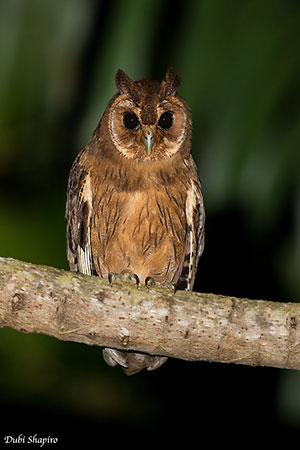
The juvenile is paler above and the back is greyish-brown. Rest of plumage is usually dull pale cinnamon-buff. The facial disc is dark chestnut, becoming tawny at top.
RANGE:
The Jamaican Owl is endemic to Jamaica where it is common from the coast to mid-elevations.
HABITAT:
The Jamaican Owl frequents a variety of forest and edge habitats, and can be found in woodlands, field edges, parks and gardens. It is less frequently seen in open park-like areas and rarely occurs at high elevations. It is usually visible up to 600 metres.
CALLS AND SONGS: SOUNDS BY XENO-CANTO
The Jamaican Owl’s main call is a breathy roar of about 1 second “whaaARRrrhh”. It also gives a higher, repeated “who-whooo who-whoo” usually heard at dusk and before dawn.
The female’s voice is typically lower.
The begging call of the juvenile is a thin, high screech “wheee-eee”.
BEHAVIOUR IN THE WILD:
The Jamaican Owl feeds mainly on large insects (beetles) and spiders, but also mice, lizards, frogs, small birds and rodents. It is a generalist predator and hunts mainly at dawn and dusk.
It is nocturnal and arboreal, and during the day, it regularly uses the same roost.
The courtship displays are not described, but usually in the family Strigidae, the male is very vocal before the nesting period in order to attract a female, or to strengthen the pair-bonds with its mate. Aerial displays and courtship feeding probably occur.
The Jamaican Owl is resident on the island.
It is agile and the flight is rapid and graceful. It also glides silently close to the ground when hunting.
REPRODUCTION OF THIS SPECIES:
The breeding season occurs from December to June, but it is uncertain.
The Jamaican Owl nests in tree cavity or in fork of branches where the nest is concealed by bromeliads and foliage.
The female lays two white eggs. At hatching, the downy chicks are covered with white down.
PROTECTION / THREATS / STATUS:
The Jamaican Owl has restricted range in which it is vulnerable to habitat loss caused by heavy deforestation. This species may also be persecuted by inhabitants who kill this owl due to superstitious beliefs.
However, the Jamaican Owl is considered as fairly common throughout the island, and it is not globally threatened. The population is suspected to be declining due to habitat destruction, but the species is currently evaluated as Least Concern.
Fr: Hibou de la Jamaïque
Ang: Jamaican Owl
All: Jamaikaeule
Esp: Búho Jamaicano
Ita: Gufo della Giamaica
Nd: Jamaicaanse Uil
Sd: jamaicauggla
Photographer:
Dubi Shapiro
Dubi Shapiro Photo Galleries & Dubi Shapiro's Pictures on IBC
Text by Nicole Bouglouan
Sources:
HANDBOOK OF THE BIRDS OF THE WORLD Vol 5 by Josep del Hoyo-Andrew Elliott-Jordi Sargatal - Lynx Edicions - ISBN: 8487334253
OWLS OF THE WORLD – By Claus König, Friedhelm Weick and Jan-Hendrik Becking - IBSN 978-0-7136-6548-2
BIRDS OF THE WEST INDIES – by Herbert Raffaele, Kristin Williams et Tracy Pedersen – Helm – ISBN: 9780713649055
A Photographic Guide to the Birds of Jamaica by Ann Haynes-Sutton, Yves-Jacques Rey-Millet, Audrey Downer, Robert Sutton – Editor: Bloomsbury Publishing, 2010. ISBN: 1408133229, 9781408133224 - 336 pages
Owls of North America and the Caribbean De Scott Weidensaul – Editeur: Houghton Mifflin Harcourt, 2015 – ISBN: 0547840039, 9780547840031 - 333 pages
Owling.com - The largest US website totally dedicated to owls
Neotropical Birds – Cornell Lab of Ornithology
Jamaican Owl
Pseudoscops grammicus
Strigiformes Order – Strigidae Family
INTRODUCTION:
The Jamaican Owl is endemic to Jamaica where it is described as “fairly common” on lower mountain slopes and in open wooded habitats.
This species is arboreal and entirely nocturnal. It feeds on invertebrates and small vertebrates.
The Jamaican Owl is vulnerable to destruction of the habitat through deforestation. However, the species is not currently globally threatened.
DESCRIPTION OF THE BIRD:
Biometrics:
Length: 27-34 cm
The Jamaican Owl is a medium-sized Strigidae with conspicuous ear-tufts.
Crown and upperparts are tawny-brown with fine, black vermiculations. Both flight-feathers and rectrices are short with irregular dark brown barring.
On the underparts, breast and belly are rufous with fine, long, dark brown shaft streaks and fine, brown, horizontal vermiculations. The underwing is pale cinnamon with darker outer primary coverts. The undertail is pale grey-brown with 8-10 narrow dark bars.
On the head, crown and forehead are mottled dark brown. The facial disc is reddish to pale yellowish-brown and narrowly bordered whitish near the dark ruff, almost forming a double ruff around the face. The obvious ear-tufts are rather long, mottled brown and blackish.
The bill is bluish grey. The large dark eyes are hazel. The legs are reddish-brown and feathered to the base of the greyish-brown toes. The claws are brown with black tips.
Male and female are similar.
